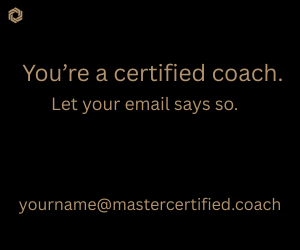Something has changed in sales. Superhuman skills don’t set people apart anymore — but being authentically human sure does.
That’s especially true as artificial intelligence (AI) tools proliferate. The problem is that many of us don’t understand AI tools or how to use them best.
Yes, you can use AI to outsource tasks like content generation. Yes, you can have AI take over your web intake and chatbots. But what separates effective AI use in sales is how well you understand what the current technology does well — and when you need the deft touch of a human hand.
AI isn’t here to replace your sales process. It’s here to refine it. Here’s how.
Understanding AI’s Current Role in Sales
Today, sales AI is a set of language-learning tools capable of processing mounds of sales data. AI can summarize a phone conversation transcript, reply to customer inquiries via chat or email, or even “talk you through” a sales strategy.
If you’re a coach running your own business, the implications are meaningful. AI tools make it possible to process client data to enhance lead generation, personalize your outreach with a few clicks, or handle data analysis to spot growth opportunities.
What AI can’t do is replace your emotional intelligence.
AI can’t “be present” with you. It will never feel like a human helping other humans. So rather than viewing AI as a replacement for your client-facing work, you’ll make much more progress if you think of AI as a set of support tools for now.
If you’re a coach looking to grow, you’ll get the best benefits when you use AI to outsource the less-human aspects of running your business:
Automating Mundane Tasks
Imagine you’re running a restaurant. Right now, AI does best when it’s in the back of the restaurant, helping plan schedules and optimizing your next order of dishwashing soap. The human element—servers, specials, and customer service—still belongs to humans.
It works the same in your coaching business.
You likely spend time scheduling calls and follow-ups, building email sequences, and sifting through meeting notes to try and decipher what potential clients are looking for.
Forrest Dwyer, customer success lead at Close, said his team gets a lot of mileage out of AI summary tools, wherein AI takes entire meeting transcripts and highlights the key points. Otherwise, the temptation is to spend too much time digging into these transcripts for insights.
“Sometimes, overanalysis is the death of cold-calling,” said Forrest. AI helps eliminate overanalysis with quick summaries, distilling mountains of calls, transcripts, and sales lead information into at-a-glance insights.
Lead Generation and CRM Tools
AI-driven CRMs or automated outreach software can help identify and nurture leads. AI can process intake data — such as contact forms or client applications — and gauge where someone fits into your business funnel.
Forrest said one of the most powerful AI tools the Close sales team uses is for AI transcript summaries. The feature quickly processes this data and turns it into action items, which makes for a more efficient —and timely — business development process.
Scaling Personalization
Ever encountered an AI chatbot attempting “small talk” with you? Yikes.
There’s something stale and mechanical about it — and potential clients pick up on that. But if you remember AI can support your personalization efforts, you can create more relevant messaging at greater scale — even as a solo coach.
Forrest said the problem is that AI can frustrate people when used too aggressively. They get annoyed when they spend too much time talking to AI.
To avoid this, Forrest recommends not scaling too quickly. Too many businesses embrace AI as if it will replace the entire client journey.
But that’s too much, too quickly. Yes, AI makes your workflow more efficient, but it leads to other consequences — like frustrated prospects who just want a real human to talk to.
Sales Forecasting and Analytics
While you focus on coaching conversations and building trust with clients, AI can work on the backend by processing data that feeds into your CRM or sales tools.
AI can log each interaction and then analyze it for trends. Are there moments when people tend to book a discovery call? Do you notice common hesitations before clients commit? This is where AI shines. It doesn’t replace human intuition, but it can help highlight the most relevant insights to improve your outreach and conversion processes.
Why Human Touch Is Still Essential
Coaches are experts at building human connections. The problem is that when a business uses AI tools too aggressively to achieve those same connections at scale, it tends to crowd out genuine relationships in favor of efficiency.
AI can be helpful for a lot of reasons. But it has yet to replace authentic rapport. Today’s clients still seek assistance from a genuine connection. We want to feel like someone is in our corner.
In a recent presentation at the ICF Tennessee Charter Chapter Conference, sales coach and consultant Joyce Kyles said, “[coaches] create such a sacred space with our clients.” The reason: empathy. Effective coaching often comes not from offering solutions but from listening and reflecting.
Using AI language models to simulate those human relationships — from coach to client or business to customer — can leave something missing. That’s why AI’s role is best as a back-end supporter, not a human substitute.
Your human team does.
So, before you replace the human touch with AI, start by incorporating AI into the least-human aspects of your sales funnel first. AI can populate your CRM data, take down transcripts, and analyze sales reports. But even with all that information, it’s probably not ready to make a sale.
Overcoming AI Fears and Barriers
Some businesses fail customers because they overdo AI, losing the human element. But there’s another end to this spectrum: you can let your AI fears run so rampant that you end up using AI too little.
To be fair, some AI concerns are legitimate. If you handle sensitive client data, privacy is a critical issue to work through. If you work in specialized or regulated areas, AI may struggle to provide accurate insights.
To overcome both fears and barriers, here are a few recommendations:
- Test your AI for accuracy first. Forrest notes: “When [AI] becomes much more actionable, it’ll be much more interesting.” Use it to process information — but don’t rely on it to lead strategy until you understand its limitations.
- Stop fearing AI as a “replacement” force. Just as other tools — the typewriter, the computer — didn’t replace professionals, AI won’t replace coaching. If anything, using it more will show you how limited it still is when it comes to the deep work of coaching.
At the ICF Tennessee Charter Chapter Conference, Dr. Aikyna Finch pointed out that fears shouldn’t drive our actions. “You may not like social media,” said Aikyna, “but guess what? It’s there.” The same goes for AI. If you’re not using it, you may be missing tools that can free up your time and improve your processes.
Tools like ChatGPT and DALL-E can help generate content for newsletters or social media. And when you do, you may discover that it eliminates some of your least favorite admin tasks.
Make AI Work for You
AI is an automation tool, not a fully functional automation. Use it that way. Let AI automate administrative duties like content creation, social media management, and data analysis — while you focus on the relationship-building and personal insight that make coaching so powerful.
But don’t reject AI completely. Use it to help identify trends and shortcut manual processes like scheduling follow-ups and processing call transcripts. Over time, you’ll find that AI can support — not substitute — your coaching practice.
Disclaimer
The views and opinions expressed in guest posts featured on this blog are those of the author and do not necessarily reflect the opinions and views of the International Coach Federation (ICF). The publication of a guest post on the ICF Blog does not equate to an ICF endorsement or guarantee of the products or services provided by the author.
Additionally, for the purpose of full disclosure and as a disclaimer of liability, this content was possibly generated using the assistance of an AI program. Its contents, either in whole or in part, have been reviewed and revised by a human. Nevertheless, the reader/user is responsible for verifying the information presented and should not rely upon this article or post as providing any specific professional advice or counsel. Its contents are provided “as is,” and ICF makes no representations or warranties as to its accuracy or completeness and to the fullest extent permitted by applicable law specifically disclaims any and all liability for any damages or injuries resulting from use of or reliance thereupon.
Authors
Sponsors
Sorry, we couldn't find any posts. Please try a different search.
Post Type
Blog
Audience Type
Experienced Coaches, External Coaches, New Coaches, Professional Coaches
Topic
Future of Coaching, Technology
Related Posts
Walking the Talk: Reflective Practice for Coaches
Embodying presence and self-care through ICF Competency 2. This article explores how…
Why Transformational Coaching Will Always Be Human
As artificial intelligence (AI) gains power and popularity, many coaches are asking,…
Coaching for Growth at Alberta’s Municipal Climate Change Action Centre
It started with two colleagues sharing a passion for sustainability. Professional coach…








